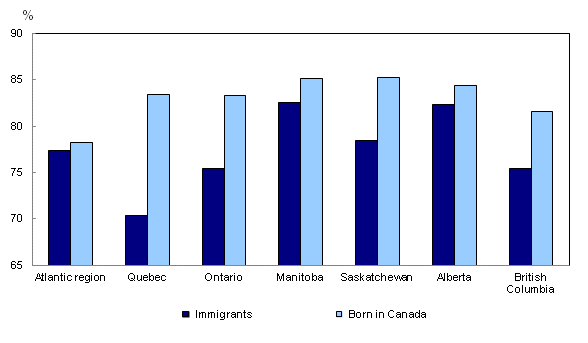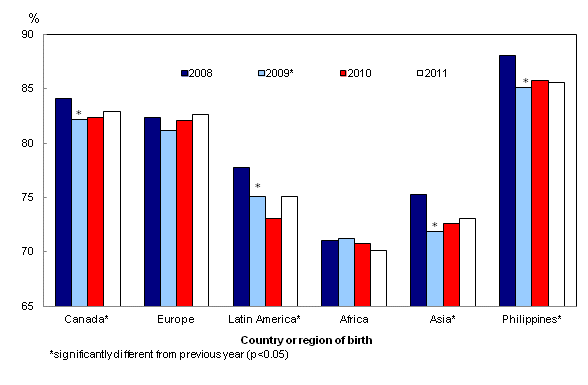Study: Canada's immigrant labour market, 2008 to 2011
Archived Content
Information identified as archived is provided for reference, research or recordkeeping purposes. It is not subject to the Government of Canada Web Standards and has not been altered or updated since it was archived. Please "contact us" to request a format other than those available.
Related subjects
-
[an error occurred while processing this directive]
In 2011, employment among landed immigrants in the core working-age group of 25 to 54 increased 4.3% from the previous year. The majority of the growth occurred among established immigrants who had been in the country for more than 10 years. Over the same period, employment among core-aged Canadian born was virtually unchanged.
The employment rate of core-aged immigrants in 2011 was 75.6%, compared with 82.9% for their Canadian-born counterparts. (The employment rate for any given group is the number of employed as a share of the total population in that group.)
The 2011 employment rate for core-aged landed immigrants was still 1.8 percentage points lower than in 2008, the start of the economic downturn. This was mostly because their growth in employment did not keep pace with the growth in their population.
Among Canadian born, the employment rate also fell between 2008 and 2011, down 1.2 percentage points. This was, however, the result of employment decline (-1.8%), as their population remained relatively stable.
Employment rates were progressively higher the longer immigrants had been in the country. In 2011, these rates ranged from 63.5% among those in the country for five years or less (very recent immigrants) to 79.8% among those here for more than a decade.
Immigrant employment rates highest on the Prairies
Immigrants living on the Prairies and in British Columbia accounted for more than half the growth in employment among Canada's landed immigrants in 2011.
While these immigrants made up 31% of Canada's immigrant workforce, they accounted for 53% of the immigrant employment growth in 2011 compared with the previous year.
In Saskatchewan, where the overall labour market was relatively stable during the downturn, immigrant employment showed increases. Employment growth for very recent immigrants, in particular, doubled between 2008 and 2011. This brought their employment rate to 77.0%, second highest after their counterparts in Manitoba.
Rate of employment among immigrants and Canadian born aged 25 to 54, by province or region, 2011

In Alberta, the gap in employment rates between immigrants and the Canadian born was among the lowest in the country. In fact, established immigrants in the province had an employment rate of 85.6%, higher than that of their Canadian-born counterparts (84.4%).
In Manitoba, the employment rate of all core-aged immigrants was 82.5% in 2011, the highest among the provinces, compared with 85.1% for their Canadian-born counterparts.
In Central Canada, employment rates for all core-aged immigrants were below the national average of 75.6%. In Ontario, the rate was 75.4% and in Quebec it was 70.3%, the lowest among the provinces.
The employment rate for immigrants in the Atlantic provinces was lower than the rate for the Canadian born (77.4% versus 78.2%, respectively). Core-age immigrants in these provinces make up 4% of the total core-age population in the region, the smallest share in the country.
Immigrant employment by industry
From 2010 to 2011, employment growth (+4.3%) among core-aged immigrants was most notable in health care and social assistance as well as information, culture and recreation. In contrast, employment among core-aged Canadian born was little changed in all industries except construction, where it rose by 5.3%.
Compared with 2008, the year the downturn started, immigrant employment was 4.6% higher in 2011, with notable increases in a number of industries, including health care and social assistance; professional, scientific and technical services; public administration; as well as business, building and other support services. However, immigrant employment in manufacturing was still below the pre-downturn level.
In 2011, total employment among the Canadian born was below its pre-downturn levels, as gains in health care and social assistance as well as construction were offset by losses in manufacturing, in retail and wholesale trade and in other industries.
Employment rates by sex
The gap in employment rates between male immigrants and their Canadian-born counterparts has traditionally been narrower than the gap between female immigrants and their Canadian-born counterparts.
In 2011, the employment rate for core-aged male immigrants was 83.0%, compared with 85.5% for Canadian-born men in this age group. Among immigrant men who had been in the country for five years or less, the gap was larger, with their employment rate at 75.7%.
For core-aged female immigrants, the employment rate in 2011 was 68.8% compared with 80.3% for their Canadian-born counterparts. This gap was similar to previous years. Women who were very recent immigrants had a much lower employment rate (52.5%).
Immigrant labour market by country of birth
Since 2006, when the immigrant labour force data series started, immigrants born in the Philippines have had the highest employment rate of all groups, including those born in Canada, who ranked second, while immigrants born in Europe had the third-highest rate.
In 2011, nearly half (48%) the immigrant labour force of the core working-age was born in Asia. Those born in the Philippines made up 18% of this population, second only to India (19%) and well ahead of China (14%).
The employment rate in 2011 among Filipino-born immigrants aged 25 to 54 was 85.6%, higher than the rate of 82.9% for the Canadian-born population and well above the rate of 73.1% for the Asian-born population as a whole.
Highest employment rate among immigrants born in the Philippines

Chart description: Highest employment rate among immigrants born in the Philippines
Also since 2006, African-born immigrants have had the lowest employment rate of all immigrants. In 2011, their rate was 70.1%. African-born immigrants make up nearly 10% of the immigrant labour force aged 25 to 54.
African-born immigrants who had been in the country for five years or less, in particular, faced more difficulties in the labour market. Their employment rate was 55.7% in 2011. In contrast, their African-born counterparts who had been in the country more than 10 years had an employment rate of 77.3%.
Note to readers
This report uses data from the Labour Force Survey to examine the labour market situation of immigrants between 2008 and 2011. The analysis focuses on immigrants in the core working-ages between 25 and 54. Individuals in this age group are most likely to have finished their schooling and to have not yet retired from the workforce.
This report examines labour market outcomes for core-aged people by province, industry, educational attainment, socio-demographic characteristics, and country or region of birth. It also contains a brief analysis of immigrant wages.
Available without charge in CANSIM: tables CANSIM table282-0101 to 282-0108.
Definitions, data sources and methods: survey number survey number3701.
A more detailed summary, "The Canadian Immigrant Labour Market from 2008 to 2011" as part of The Immigrant Labour Force Analysis Series (Catalogue number71-606-X, free), is now available online. From the Publications module of our website, under Publications by subject choose Labour.
For more information, contact us (toll-free 1-800-263-1136; infostats@statcan.gc.ca).
To enquire about the concepts, methods or data quality of this release, contact Lahouaria Yssaad (613-951-0627; lahouaria.yssaad@statcan.gc.ca), Labour Statistics Division.
- Date modified:
